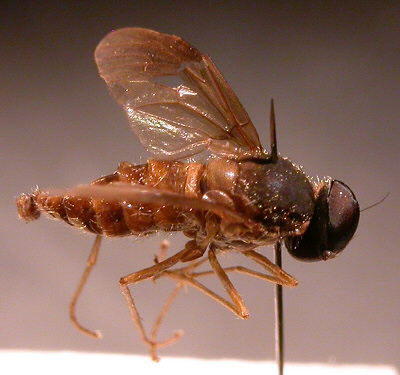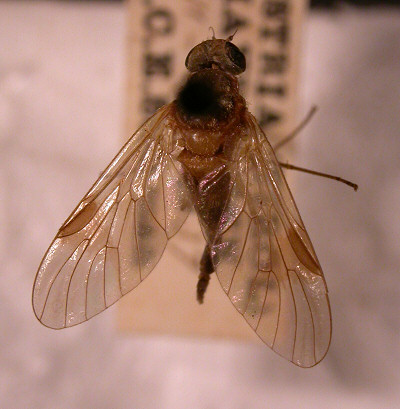1.b. Wing hyaline except for the pterostigma (if a vague brown tint around the pterostigma, then larger than 10 mm) -> 5
2.a. Wing with a dark patch extending from the pterostigma, very tip hyaline -> 3
2.b. Wing darkened in tip third; abdomen yellowish brown with yellow hairs; thoracic dorsum blackish. 5-7.5 mm. -> Chrysopilus pullus

3.a. Male: the swelling on the face has the form of a pear, it is higher than wide, the distance from the upper border of the swelling and the antennal implant is shorter than the heigth of the swelling; abdomen yellow. Female: abdomen dark cinnamon. Both sexes: head grey with the swelling cinnamon. 6.5-8.5 mm. -> Chrysopilus nubeculus

3.b. Male: the swelling on the face round, as high as wide, the distance from the upper border to the antennal implant is longer than the height of the swelling. Female: abdomen largely yellow -> 4
4.a. Thorax and abdomen yellow (tip segments sometimes with dark bands); head black; antenna: 1st and 2nd segment yellow, 3rd segment black, 3rd segment as wide as the 2nd; wing: dark patch weakly developed. 6.5-7 mm. -> Chrysopilus laetus
4.b. Abdomen yellow brown, thoracic dorsum and sides darkened; antenna: 3rd antennal segment wider than the 2nd. 6-8 mm. -> Chrysopilus luteolus

5.a. Wing: pterostigma not large, yellow to dark; length less than 10 mm -> 6
5.b. Wing: pterostigma outstanding large and dark, surrounded with a vague brown tint; femora blackish. Female: abdomen with silver bands. Large: 10-14 mm. -> Chrysopilus erythrophthalmus

6.a. Wing: pterostigma partly dark brown, well marked in wing -> 7
6.b. Wing: pterostigma yellow brown, vaguely marked -> 9
7.a. Femora dark brown to black. Female: thoracic dorsum grey with 2-3 dark stripes -> 8
7.b. Femora yellow; thoracic dorsum uniformly greyish black. 5-6 mm. -> Chrysopilus aureus

8.a. Head: the hairs between the mouth opening and the lower border of the eye black; hind part pale greyish; abdomen: sternites brownish black. Female: thoracic dorsum on the front part with a broad grey stripe containing a small black stripe in its middle. 6.5-8.5 mm. -> Chrysopilus auratus


8.b. Head: the hairs between the mouth opening and the lower border of the eye whitish; hind part of head dark greyish; abdomen: sternites dark greyish. Female: thoracic dorsum on front part with a broad blackish stripe, the dorsum often largely blackish by accompanying black patches. 6-7 mm. -> Chrysopilus splendidus


9.a. Femora brown. 7-10 mm. -> Chrysopilus flaveolus
9.b. Femora black on basal quarter, yellow otherwise; coxa, palpi and antenna blackish. Males: eyes separated on frons; palpi long, almost reaching antennal base. 8-10 mm. -> Chrysopilus helvolus
